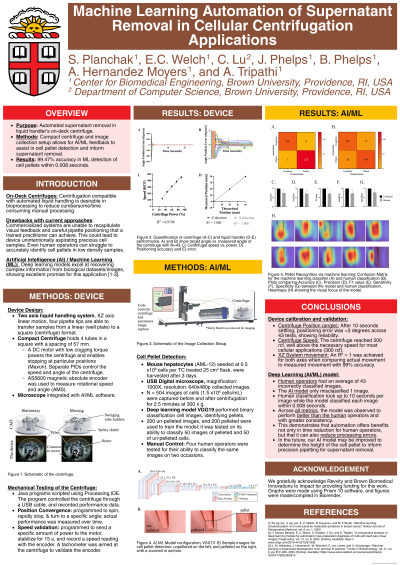Screening Applications & Diagnostics
Poster Session A
(1040-A) Machine Learning Automation of Supernatant Removal in Cellular Centrifugation Applications
Tuesday, May 28, 2024
16:30 - 17:15 CEST
Location: Exhibit Hall


Sarah Planchak, MEng (she/her/hers)
Miss
Brown University
Providence, RI, United States
Poster Presenter(s)
Abstract: Centrifugation is a common laboratory technique that is frequently used in a variety of clinical and research applications. Centrifugation of cellular samples is routinely performed in cell culture, tissue engineering, high-throughput screening, and diagnostic applications, for example. In recent years, significant advancements have been made in automating pipetting, with the commercialization of several liquid handling robotic technologies. The integration of centrifugation with automated liquid handling is a desirable technology in numerous bioprocessing applications in order to reduce the manual sample preparation steps that are associated with traditional centrifugation approaches, which can be cumbersome and time consuming. While certain commercialized systems have been designed that incorporate these two technologies together, these can be large, heavy, and difficult to integrate with liquid handling systems. Furthermore, precise tube and pipette tip positioning remains a challenge in cellular applications, wherein it is easy to disturb the cell pellet and unintentionally aspirate cells. Herein, we have detailed a fully automated, compact centrifuge integrated with a liquid-handling robotic system that uses machine learning image classification to streamline cell sample processing. The design of the centrifuge enables precise position control as well as sample collection and dispersal to other parts of the device. The automation of processing functions improves not only the ease of use of the device by limiting hands-on time, but also processing results. The machine learning classification system enhances cell pellet detection, offering notable advantages in accuracy, precision, F1, sensitivity, and specificity. This automated device approach demonstrates improvements in cellular bioprocessing with a variety of clinical, industrial, and research applications.
